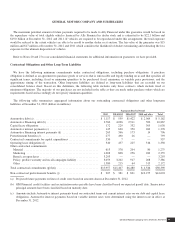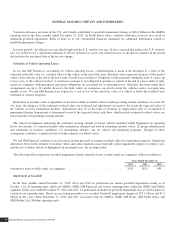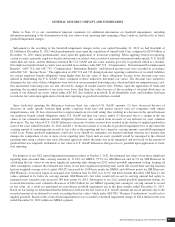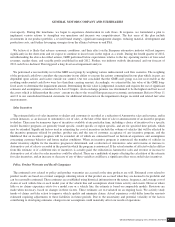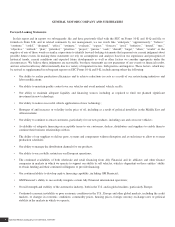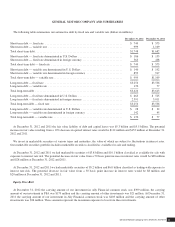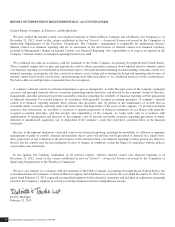General Motors 2012 Annual Report Download - page 64
Download and view the complete annual report
Please find page 64 of the 2012 General Motors annual report below. You can navigate through the pages in the report by either clicking on the pages listed below, or by using the keyword search tool below to find specific information within the annual report.
GENERAL MOTORS COMPANY AND SUBSIDIARIES
overcapacity. During this timeframe, we began to experience deterioration in cash flows. In response, we formulated a plan to
implement various actions to strengthen our operations and increase our competitiveness. The key areas of the plan include
investments in our product portfolio, a revised brand strategy, significant management changes, reducing material, development and
production costs, and further leveraging synergies from the alliance between us and PSA.
We believe it is likely that adverse economic conditions, and their effect on the European automotive industry will not improve
significantly in the short-term and we expect to continue to incur losses in the region as a result. During the fourth quarter of 2012,
notwithstanding the above described actions, GME performed below expectations relative to the key operating metrics of forecasted
revenues, market share, and variable profit established in mid-2012. Further, our industry outlook deteriorated, and our forecast of
2013 cash flows declined. This triggered a long-lived asset impairment analysis.
We performed a recoverability test of the GME asset group by weighting various undiscounted cash flow scenarios. The weighting
of the projected cash flows considers the uncertainty in our ability to execute the actions contemplated in our plan which, in part, are
dependent upon actions and factors outside our control. Our test concluded that the GME asset group was not recoverable as the
resulting undiscounted cash flows were less than their carrying amount. Accordingly, we estimated the fair value of the GME long-
lived assets to determine the impairment amount. Determining the fair value is judgmental in nature and requires the use of significant
estimates and assumptions, considered to be Level 3 inputs. An in-exchange premise was determined to be the highest and best use of
the assets which is different than the assets’ current use due to the overall European macro-economic environment. Refer to Notes 11
and 13 to our consolidated financial statements for additional information on the impairment charges recorded and related fair value
measurements.
Sales Incentives
The estimated effect of sales incentives to dealers and customers is recorded as a reduction of Automotive sales and revenue, and in
certain instances, as an increase to Automotive cost of sales, at the later of the time of sale or announcement of an incentive program
to dealers. There may be numerous types of incentives available at any particular time, including a choice of incentives for a specific
model. Incentive programs are generally brand specific, model specific or region specific, and are for specified time periods, which
may be extended. Significant factors used in estimating the cost of incentives include the volume of vehicles that will be affected by
the incentive programs offered by product, product mix and the rate of customer acceptance of any incentive program, and the
likelihood that an incentive program will be extended, all of which are estimated based on historical experience and assumptions
concerning customer behavior and future market conditions. When an incentive program is announced, the number of vehicles in
dealer inventory eligible for the incentive program is determined, and a reduction of Automotive sales and revenue or increase to
Automotive cost of sales is recorded in the period in which the program is announced. If the actual number of affected vehicles differs
from this estimate, or if a different mix of incentives is actually paid, the reduction in Automotive sales and revenue or increase to
Automotive cost of sales for sales incentives could be affected. There are a multitude of inputs affecting the calculation of the estimate
for sales incentives, and an increase or decrease of any of these variables could have a significant effect on recorded sales incentives.
Policy, Product Warranty and Recall Campaigns
The estimated costs related to policy and product warranties are accrued at the time products are sold. Estimated costs related to
product recalls are based on a formal campaign soliciting return of that product are accrued when they are deemed to be probable and
can be reasonably estimated. These estimates are established using historical information on the nature, frequency, and average cost of
claims of each vehicle line or each model year of the vehicle line and assumptions about future activity and events. However where
little or no claims experience exists for a model year or a vehicle line, the estimate is based on comparable models. Revisions are
made when necessary, based on changes in these factors. These estimates are re-evaluated on an ongoing basis. We actively study
trends of claims and take action to improve vehicle quality and minimize claims. Actual experience could differ from the amounts
estimated requiring adjustments to these liabilities in future periods. Due to the uncertainty and potential volatility of the factors
contributing to developing estimates, changes in our assumptions could materially affect our results of operations.
General Motors Company 2012 ANNUAL REPORT 61




